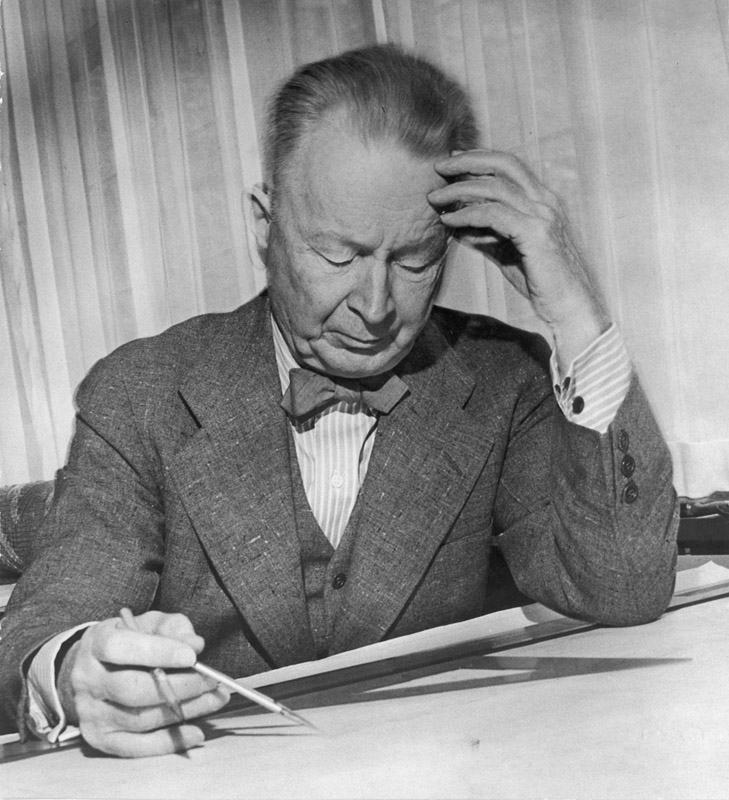
Eliel Saarinen
20.08.1873, Rantasalmi - 01.07.1950, Bloomfield Hills, Michigan, USA
Architect 1897, Polytechnic Institute, Helsinki
Eliel Gottlieb Saarinen supplemented his architectural studies at the drawing school of the University of Helsinki. While still a student, he set up an office together with his fellow students Herman Gesellius and Armas Lindgren.
The young architects were successful in design competitions. They made an international breakthrough with the Finnish Pavilion at the 1900 Paris World Fair, with frescos painted by Akseli Gallen-Kallela. The pavilion was followed by the Pohjola insurance company building and the National Museum, Helsinki, two monumental stone buildings representing National Romanticism at its purest. The trio’s joint home and studio Hvitträsk in Kirkkonummi was a total work of art typical of the time.
Log and granite, the materials favoured by National Romanticism, mark only part of the buildings by Gesellius, Lindgren, Saarinen. They drew inspiration from American business architecture as well as the light-coloured Viennese Art Nouveau. The influence of the latter is reflected in the office’s restrained private houses.
The office was closed down in 1905, after which Gesellius and Saarinen worked together until 1907. At the same time there was a change in architectural ideals, which is clearly reflected in the various design stages of the Helsinki railway station.
For Eliel Saarinen, the 1910s were a period of great town plans. After making studies for Tallinn and Budapest he concentrated on Helsinki. The Munkkinemi–Haaga plan was finished in 1915 and the Pro Helsingfors general plan in 1918. Both included thorough population prognoses, and the growth of traffic and ensuing arrangements were carefully studied. Of these large-scale plans, only a fraction of Munkkiniemi–Haaga was realized.
In 1922 Saarinen participated in a competition for the Chicago Tribune building and won 2nd pize. His elegant design aroused a lot of attention, and in hope of better assignments Saarinen moved to the United States in 1923. The next year he was nominated Professor of the University of Michigan.
Saarinen’s interest in town planning shows in the unbuilt lakeshore designs he made for Chicago and Detroit in 1923 and 24. In 1925 Saarinen was commissioned to design the Cranbrook Educational Centre in Michigan, where he built the Cranbrook School for Boys, the Kingswood School for girls, the Institute of Science and the Art Museum. His own house, designed in collaboration with his wife, textile artist Loja Saarinen, was built in 1929.
From the late 1930s on, Saarinen worked in collaboration with his son Eero. Their joint works include the Kleinhans concert hall in Buffalo and the Tabernacle Church in Indiana. The main work of the joint office was the General Motors Technical Centre in Detroit from 1949, the final drawings made by Eero Saarinen.
Saarinen’s significant publications, besides Munkkiniemi–Haaga and Pro Helsingfors, include The City published in 1943 and the Search for Form published in 1948. Saarinen was Dr. h.c. of the University of Helsinki, Helsinki University of Technology and the universities of Karlsruhe, Michigan, Harvard and Iowa.
The Eliel Saarinen collection was donated to the Finnish Association of Architects in 1952 for an architectural museum to be established later. Loja Saarinen had compiled Saarinen’s drawings into large files, which present his whole life’s work in a crystallized form. This collection formed the initial holdings of the Museum of Finnish Architecture that was established in 1956, and it still is one of its most important individual collections.
In number the Saarinen collection is not large, for when he moved to the United States, he took but a limited selection of drawings with him and left the rest to Hvitträsk to be destroyed. In the course of years the museum has acquired additional material by Saarinen. Along with systematic search, the collection has grown to over 500 drawings.
The finest sample of the work of the office Gesellius, Lindgren, Saarinen in the museum are the drawings made in 1902 for the Suur-Merijoki manor built near Viipuri (now Russia).
Eliel Saarinen developed the art of drawing into its zenith during his American period. In Finland, the best examples of this skill are his sketches for banknotes. They aroused heated debate, for the naked figures he suggested were highly unconventional motifs at the time, especially in banknotes.
